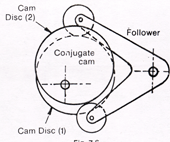Classification of cams- They are classified according to:
1. Shape
2. Follower movement
3. Manner of constraint of follower.
According to shape: -
- Wedge and flat cams: - A wedge cam has a wedge in general which has translational motion .The follower can either translate or oscillate. A spring is used to maintain contact between the cam and follower. Instead of wedge a flat plate with a groove is also used.
- Radial or Disc cam: - A cam in which the follower moves radially from the center of rotation of the cam is known as radial or disc cam. It is used due to simplicity and compactness.
- Spiral cam: - A spiral cam is a face cam in which a groove is cut in form of spiral. The spiral grooves consist of teeth, which mesh with a pin gear follower. The velocity of the follower is proportional to the radial distance of groove from axis of cam.
- Cylindrical cam: - In this cam a cylinder, which has a circumferential contour, cut in the surface rotate about it’s axis. These cams are also known as barrel or drum cams.
- Conjugate cam: - A conjugate cam is a double disc cam, two discs being keyed together and are in constant touch with two rollers of the follower.
- Globoidal cam: - A Globoidal cam can have two types of surfaces, convex or concave. A circumferential contour is cut on the surface of the rotation of cam to impart motion to the follower that has an oscillatory motion.

7. Spherical cam:- In this the follower oscillates about an axis perpendicular to the axis of rotation of the cam.






No comments:
Post a Comment